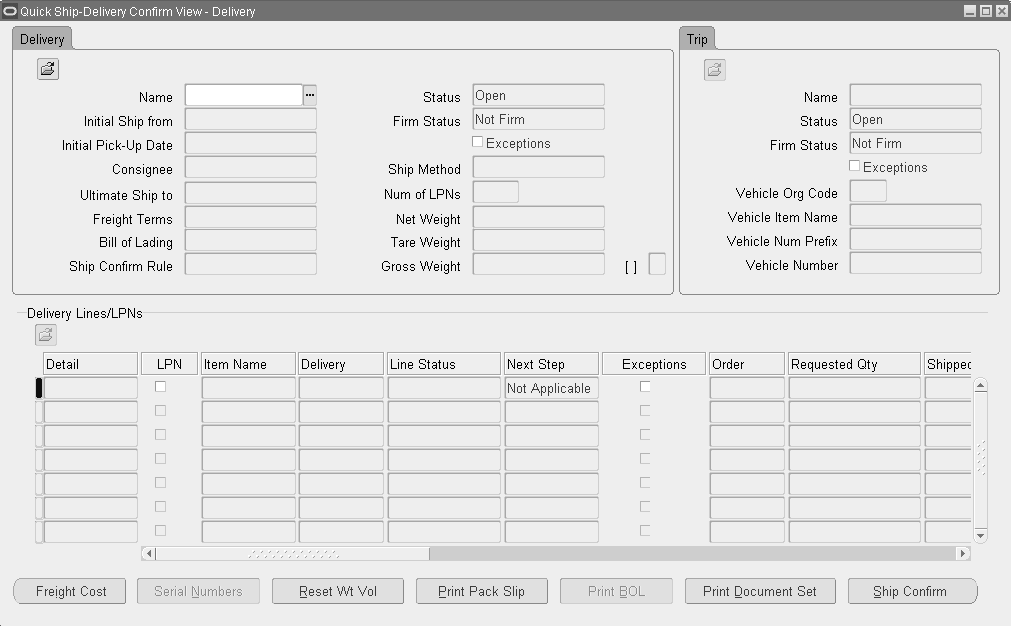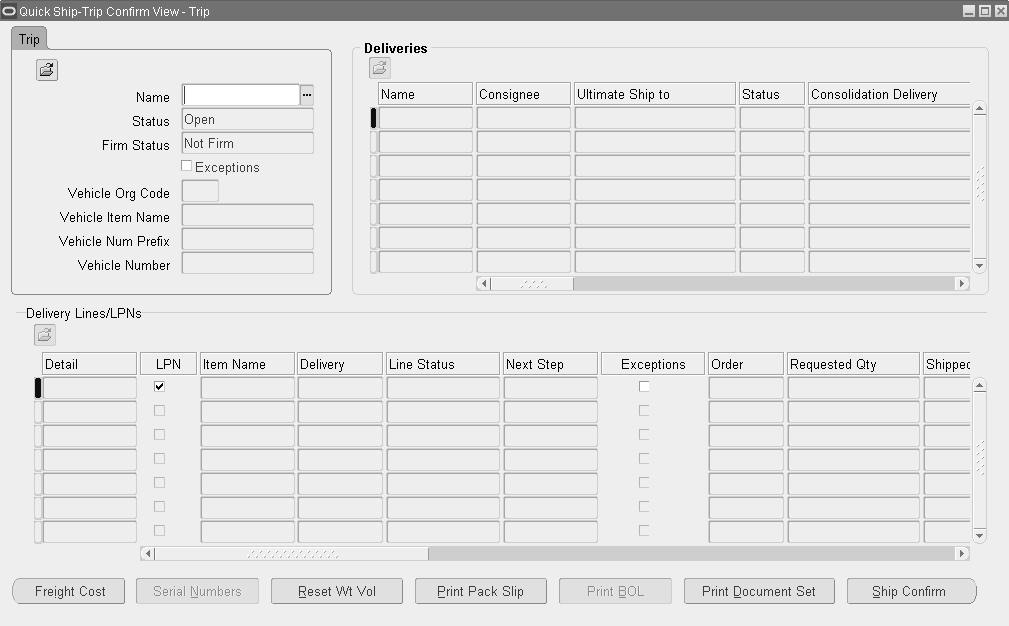Shipping
This chapter covers the following topics:
Overview of Shipping
You can manage shipping information such as trips, trip stops, deliveries, delivery lines, containers, and freight costs in the Shipping Transactions form. In addition, you can complete the following shipping tasks:
Trip and Delivery Planning:
-
Create a trip or delivery.
-
Assign delivery lines to a delivery or a container.
-
Schedule pick-ups and drop-offs.
Pick Release:
-
Release eligible delivery lines based on defined picking criteria.
-
Select the Release Sequence Rule to control the order in which picking lines are allocated to inventory.
-
Enter or validate shipped quantities, back ordered quantities, staged quantities, and inventory control information for delivery lines (after pick release).
Ship Confirm:
-
Assign delivery lines to trips and deliveries.
-
Auto-create a trip and close stops.
-
Ship confirm or back order a delivery.
Shipping Transactions Form
The Shipping Transactions form provides a consolidated workbench. It enables you to plan and manage trips, stops, deliveries, delivery lines, and LPNs (containers).
Note: The entity fields in the Shipping Transaction form are keyboard navigable even if they are display-only. You can use the folder functionality to rearrange the fields to optimize the data entry and update.
Shipping Transactions Form

When you navigate to the Shipping Transactions form, the Query Manager window opens on top of the Shipping Transactions form automatically, enabling you to search for trips, deliveries, delivery lines, LPNs, and stops. You can either move the Query Manager window to view the Shipping Transactions form that is behind it, or close the Query Manager window to view the Shipping Transactions form.
With the Shipping Transactions form, you manage information about shipping entities, and complete the following tasks:
-
Plan trips, stops, deliveries, and delivery lines/containers
-
Ship confirm a delivery or trip
-
Track shipments
-
Track shipping containers
-
Handle over and under shipments
-
Initiate intrastate (European) transactions
-
Pick release trip, stop, delivery, delivery lines, and container
-
Run reports
-
Enter details about a shipment, such as, weights, waybill numbers, tracking numbers, serial numbers and freight costs
-
View delivery and trip workflows
The Shipping Transactions form is right-click enabled. You can perform actions by right-clicking on the window and selecting the desired action.
Although buttons are active when no data exists on the Shipping Transactions form, if you attempt to use the buttons no action will be performed and a warning message will be displayed. This is also the case when buttons are active when the action of that button is not possible. For example, when a delivery line is assigned to a delivery, the Autocreate Deliveries button is active, and if you click that button a warning message will be displayed stating that the delivery line is already assigned to a delivery.
Note: The Shipping Transactions form does not refresh the main tabbed region after an action is performed within a detailed tabbed region.
Folders
Using folder options, you can define your own prompt (name) for specific buttons on the window and you can hide or display any field except for the first column in each window. You can select up to three items from the action menu to appear as buttons in each window.
To enable folder options
-
From the Folder menu, select New.
-
Within the Create New Folder window, enter a unique folder Name.
-
Select the options for this folder.
Select Open as Default Folder if you want this folder to be your default folder. Select Public if you want to enable anyone to be able to use this folder. Accept or define your own prompt name for the buttons and Enable or disable the Display of the buttons (you can display a maximum of three buttons at a time).
-
Click OK.
-
Select the Folder pull down menu.
-
Click Save.
Note: The options in the folders change depending on the window from which you are designating them.
Note: You can customize the fields displayed in the Shipping Transactions form by adding or hiding fields to suit your business requirements.
To show additional fields or hide existing fields, place the cursor in any column and either select Folder (from the Tools menu) > Show Field to display additional fields or Folder > Hide Field to hide selected fields, or you can right-click in any field, select Folder, then the folder option, such as Show Field. To change the prompt name of any column heading, right click on the prompt name and enter a new name.
You can save the updated Shipping Transactions form layout and use it as the new default (or you can select the original default).
To save the changes to the Shipping Transactions form layout as updates to the existing folder, select Folder > Save. To save the changes as a new folder, select Folder > Save As.
To open a saved folder, click the Open Folder icon located in the Shipping Transactions form.
Note: The Shipping Transactions form includes the following Oracle Process Manufacturing fields: Grade, Secondary Requested Quantity, Secondary Picked Quantity, Secondary Shipped Quantity, Secondary Backordered Quantity, Secondary Stage Quantity, Secondary Delivered Quantity, Secondary Requested Quantity UOM, Secondary Cancelled Quantity, Secondary Source Requested Quantity, and Secondary Source Requested Quantity UOM.
To view these fields, choose Folder > Show Fields. Select the fields from the list of values. If the Oracle Process Manufacturing (OPM) item is dual UOM controlled or lot controlled, and has a grade, then you will see values in these fields. Otherwise, these fields will be blank. Refer to Using Oracle Order Management with Process Inventory for description of process fields.
Quick Ship Window
The Quick Ship window enables you to process shipments quickly, using the minimum shipping requirements with the benefit of form layout configurability. You can access deliveries, trips, and delivery lines/LPNs within the Quick Ship window.
Note: The entity fields in the Quick Ship window are keyboard navigable even if they are display-only. You can use the folder functionality to rearrange the fields to optimize the data entry and update.
Note: Oracle Warehouse Management provides a feature named Quick Ship. The Quick Ship window in Oracle Shipping Execution is in no way related to the Quick Ship feature of Oracle Warehouse Management.
Quick Ship does not require that you enter the amount of detailed information typical of the Shipping Transactions form, rather the bare minimum requirements are used to process a shipment.
The following tasks are performed using the Quick Ship window:
-
Ship confirm deliveries
-
Enter ship quantities
-
Ship confirm trips
-
Print shipping documents
-
Enter delivery freight costs
-
View and resolve shipping exceptions
-
View delivery and trip workflows
-
Access to the Shipping Transactions form
Note: All Roles and Grants that are applicable in the Shipping Transactions form are also applicable in the Quick Ship window.
The Quick Ship window is configurable. Using the Folders feature, you can hide fields, show fields, and add tabs to the window.
Although buttons are active when no data exists on the Quick Ship window, you cannot perform the selected action without the required data, and a warning message is displayed with this information if you attempt to execute an active button without information.
Note: The Quick Ship window is right-click enabled. You can perform actions by right-clicking on the window and selecting the desired action. You can also access folder options by right-clicking. All available actions, as well as all available Folder options, are available by right-clicking within the window.
You have a choice of the default view of the Quick Ship window by defining the shipping parameter WSH: Quick_Ship_Default_View_Mode. The available default views to choose from include:
-
Delivery Confirm view: Delivery Confirm view displays one delivery record in the delivery region
-
Trip Confirm view: Trip Confirm view displays multiple deliveries in the delivery region
The Delivery Confirm view displays three regions with multiple fields. Additional fields can be displayed by right-clicking, choosing Folder, then Show Field.
Within the Quick Ship window, you can display all the same field prompt names that are available in the Shipping Transactions form.
The Trip Confirm view displays the same three regions, however the Deliveries region lists the fields in a horizontal table view.
You can navigate to the Shipping Transactions form from the Quick Ship window by selecting Shipping Transactions Form from the Tools menu. Depending on where your cursor is located within the Quick Ship window will determine which window opens in the Shipping Transactions form. For example, if your cursor is in the Delivery Name field when you select Shipping Transactions Form, the Delivery window will open. If your cursor is in the Trip Name, then the Trip window opens when you select Shipping Transactions Form. If your cursor is in the Detail field, then the Detail window opens when you select Shipping Transactions Form.
Changing the Quick Ship Window View:
You can change the current view of the Quick Ship window from the Delivery Confirm view (default) to Trip Confirm view, to suit your business needs. If you typically ship confirm deliveries, then you will want to default the Delivery Confirm View. However, if you typically ship confirm trips, then you might prefer to set the default to the Trip Confirm View.
You can change the default view by defining the profile option WSH: Quick_Ship_Default_View_Mode.
To change the Quick Ship window view
-
Navigate to the Quick Ship window.
Quick Ship - Delivery Confirm View - Delivery Window

-
From the Tools menu, select Change View.
Quick Ship-Trip Confirm View - Trip Window

-
Done.
Related Topics